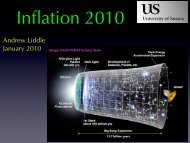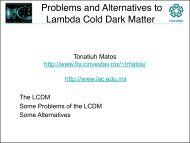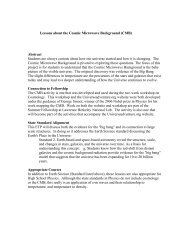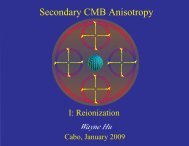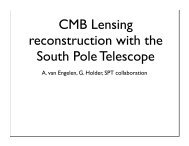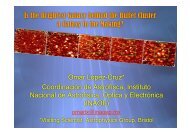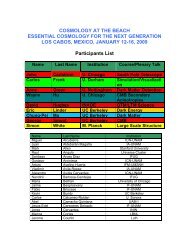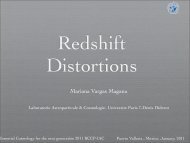The Large Millimeter Telescope - Berkeley Center for Cosmological ...
The Large Millimeter Telescope - Berkeley Center for Cosmological ...
The Large Millimeter Telescope - Berkeley Center for Cosmological ...
Create successful ePaper yourself
Turn your PDF publications into a flip-book with our unique Google optimized e-Paper software.
<strong>The</strong> <strong>Large</strong> <strong>Millimeter</strong> <strong>Telescope</strong><br />
David Hughes<br />
Project Scientist LMT<br />
Instituto Nacional de Astrofisica, Optica y Electronica<br />
(INAOE) Tonantzintla, Mexico
May 2008<br />
Overview<br />
• LMT & specifications<br />
• first-light instrumentation<br />
• LMT cosmology key projects<br />
(high-resolution studies of<br />
CMB anisotropies and LSS)<br />
www.lmtgtm.org<br />
Funding<br />
Mexico: CONACYT, INAOE<br />
USA: NSF, DARPA, UMASS
<strong>The</strong> LMT/GTM project<br />
<strong>The</strong> LMT book El libro del GTM<br />
http://www.lmtgtm.org/book/lmtbook.html http://www.lmtgtm.org/gtm/book/librogtm.pdf
Primary Science with the LMT<br />
<strong>The</strong> <strong>for</strong>mation & evolution of structure in the Universe
Cosmology at millimeter-wavelengths<br />
• can detect the earliest evolutionary stages of structure<br />
<strong>for</strong>mation in planet-<strong>for</strong>ming and star-<strong>for</strong>ming regions<br />
(cold, dense, optically-thick dust-obscured environments)<br />
• independence of flux density on distance means we can<br />
detect starburst galaxies in the high-z Universe (which contribute<br />
~50% of the γ-ray to radio extragalactic background light)<br />
• rich molecular-line spectrum to understand physical<br />
conditions of star<strong>for</strong>mation, the ISM, gas mass,<br />
spectroscopic–z & evolutionary history<br />
• we observe the CMB at the peak of its energy distribution.<br />
Sunyaev-Zeldovich effect is a powerful redshift-independent<br />
method to identify clusters in local and high-z Universe
LMT Design Characteristics<br />
• 50-m main reflector (180 panel segments)<br />
2.5 m secondary mirror<br />
• active surface (compensates gravity<br />
& thermal de<strong>for</strong>mations) to achieve<br />
surface r.m.s. of ~70 microns<br />
• operational wavelengths 0.85 - 4 mm<br />
• Beam resolution (FWHM) 5 -18 arcsec<br />
• FOV ~ 4 arcmin diameter<br />
• Sensitivity – 3.0mm 2.0 Jy/K<br />
1.2mm 3.1 Jy/K
Volcán Sierra La Negra (97 o 18’ 53” W, +18 o 59’ 06”)<br />
altitude 4600m
Location of the <strong>Large</strong> <strong>Millimeter</strong> <strong>Telescope</strong><br />
México<br />
Iztaccihautl (5110m) y<br />
Popocatepetl (5400m)<br />
La Malinche (4400m)<br />
Citlaltépetl (5740m) y<br />
Sierra Negra (LMT, 4600m)<br />
Puebla<br />
Orizaba<br />
∼100 km<br />
Golfo de México<br />
Córdoba
LMT site<br />
Volcán Sierra Negra<br />
(Tliltepetl) 4581m<br />
Pico de Orizaba<br />
(Citlalteptel) 5800m<br />
• excellent logistical support available (close to major towns/cities)<br />
• only 2 hours travel from INAOE with 110 km of autopista and 13 km<br />
of access road to summit
LMT Site Characteristics<br />
• Site - Sierra La Negra (97 o 18’ 53” W, +18 o 59 ’ 06 ” )<br />
• altitude 4600m (15100 ft.)<br />
WIND (Q1, median, Q2)<br />
• median wind-speed 2.7, 4.5, 6.7 m/s<br />
• wind speed < 10 m/s (90% time)<br />
OPACITY<br />
• median opacity Τ 225GHz ~ 0.1 (winter), 0.3 (summer)<br />
2mm PWV 6 mm PWV<br />
TEMPERATURE (Q1, median, Q2)<br />
• Day (8am – 6pm) 0.2, 2.0, 3.4 degrees Celcius<br />
• Night (8pm – 6am) -1.2, 0.3, 1.4
Monthy-averaged opacity above LMT site
225GHz opacity variations in a 24-hour period<br />
Winter Summer
LMT panel segments
• 180 segments (~5 x 3m)<br />
in 5 concentric rings<br />
• 8 sub-panels (
Surface Alignment<br />
• Inner 32-m installed (inner 3-rings)<br />
• Surface alignment (laser-tracker, holography) to<br />
reach
Effective aperture areas of (sub-)mm telescopes<br />
3mm 2mm 1.4mm 1.1mm<br />
0.85mm
Effective area of (5-ring) 50m LMT<br />
3mm 2mm 1.4mm 1.1mm 0.85mm
Effective area of (3-ring) 32m LMT<br />
3mm 2mm 1.4mm 1.1mm<br />
0.85mm
March 2006
Elevation<br />
Axis<br />
3 rd Floor<br />
AzTEC and Future<br />
Continuum<br />
Instruments<br />
M3 Mirror<br />
Site Infrastructure<br />
SEQUOIA<br />
Future 1mm<br />
Array<br />
Cassegrain<br />
Focus Instruments:<br />
Redshift/1mm RX<br />
2 nd Floor<br />
BACKENDS
First-light Instrumentation Overview<br />
Commissioned<br />
• AzTEC (JCMT 15-m, ASTE 10-m)<br />
144-pixel 1.1mm (or 2.1mm) continuum camera<br />
• SEQUOIA (FCRAO 14-m)<br />
32-pixel dual-polarization spectrometer at 85-116 GHz<br />
with 15 GHz instantaneous bandwidth<br />
• 90 GHz Redshift Receiver (FCRAO 14-m)<br />
2 pixel, dual-polarization, ultra-wideband analog<br />
autocorrelation spectrometer (instantaneous bandwidth<br />
~35 GHz) at 75-111GHz<br />
LMT technical review - INAOE 21<br />
July 2008
First-light Instrumentation Overview<br />
Under development<br />
• SPEED<br />
4 pixel (FSB) prototype continuum camera. Each pixel<br />
operates simultaneously at 0.85, 1.1, 1.4, 2.1 mm<br />
• 1.3mm SIS receiver<br />
1 pixel dual-polarization spectrometer 210-275 GHz<br />
• LMT wideband spectrometer<br />
versatile digital autocorrelator -<br />
e.g. Redshift searches BW > 10000 km/s, dnu~100 km/s<br />
quiescent Dark Clouds BW ~20km/s, dnu~0.01km/s<br />
LMT technical review - INAOE 21<br />
July 2008
Future Instrument Development<br />
• CIX (Cluster Imaging eXperiment)<br />
256-pixel 4-band multi-frequency camera based on SPEED<br />
prototype<br />
• OMAR<br />
16-pixel receiver (210-275 GHz) based on<br />
single-pixel 1.3mm SIS development<br />
• TolTEC<br />
<strong>Large</strong>-<strong>for</strong>mat continuum camera (~6400 pixels),<br />
full-sampled array filling available FOV based on<br />
successful TES development (e.g. SCUBA2,<br />
MUSTANG, MBAC, … ) or other new technologies<br />
LMT technical review - INAOE 21<br />
July 2008
UMass Holography Receiver on the LMT,<br />
Installation July 2008<br />
Sig. horn<br />
Ref. horn
LMT 12GHz holography map (inner 32-m)<br />
0.9 m resolution
SEQUOIA<br />
A cryogenic focal plane array <strong>for</strong><br />
the 85-115.6 GHz range<br />
32 pixel dual polarization 4 x 4<br />
array<br />
50-80 K noise temperature<br />
No mechanical or electrical<br />
tuning<br />
Single side-band response using<br />
just two LOs
Taurus Molecular Cloud<br />
Survey (FCRAO 14-m)<br />
Narayanan et al. 2008 ApJ in press<br />
astroph/08022556<br />
12 CO (1-0) -5 < v(kms -1 ) < 20<br />
13 CO (1-0) 3 < v(kms -1 ) < 9<br />
~45” beam FWHM<br />
0.07 km/s velocity resolution<br />
96 sq degree area and 3.1 million spectra<br />
with 1024 spectral channels - Nov 2003 – May 2005<br />
12 CO (1-0)<br />
13 CO (1-0)
LMT Cosmology Key Projects<br />
High resolution studies of LSS and CMB anisotropies<br />
• take advantage of high pt-source sensitivity,<br />
mapping speed and resolution to trace 3-d<br />
distribution of LSS down to confusion-limit<br />
(resolve ~100% of mm background)<br />
• large single-dish telescopes have all 3 capabilities
D.2. “How do galaxies arise and mature?”<br />
Dark matter (5 sq. degrees)<br />
AzTEC Cluster Evolution Survey<br />
ACES 1.1mm map (30” FWHM)<br />
we have to search <strong>for</strong> & find the “first galaxies”<br />
- a population of galaxies undergoing an initial massive burst<br />
of optically-obscured star <strong>for</strong>mation that generate a<br />
significant rest-frame FIR luminosity
D.2. “How do galaxies arise and mature?”<br />
• Statistical properties needed to understand the<br />
<strong>for</strong>mation & evolution of galaxies:<br />
- source-counts N(>S) AzTEC, TolTEC<br />
+ angular distribution<br />
- redshift distribution Redshift Search Receiver<br />
N(> z; S)<br />
- luminosity function Φ(L,z) & spatial clustering
• 144-pixel Si-Ni spiderweb<br />
bolometer array<br />
• 6” beam at 1.1mm at LMT<br />
• FOV ~2.4 sq. arcmin<br />
• NEFD < 3 mJy/Hz 1/2 conservative<br />
• mapping speed > 0.55 deg 2 /hr/mJy 2<br />
AzTEC<br />
P.I. Grant Wilson (UMASS)
AzTEC commissioning & scientific operation<br />
JCMT – 15m<br />
2005<br />
Mapping Speed<br />
ASTE – 10m<br />
2007-2008<br />
3 months continuous operation from JCMT<br />
10 months operation from ASTE (1 week<br />
down-time due to cryogen failure)<br />
used by 120+ astronomers from 12 countries<br />
on JCMT: 23-28 arcmin 2 /mJy 2 /hr<br />
on ASTE: 20-30 arcmin 2 /mJy 2 /hr<br />
on LMT (projected): 2000 arcmin 2 /mJy 2 /hr<br />
LMT – 50m<br />
> 2009
.<br />
Arp 220 (z=0.018)<br />
L FIR = 2x10 12 L <br />
. . ..<br />
Building galaxies in the early universe<br />
• feasibility of mm surveys<br />
Flux density<br />
1 mm<br />
@ LMT<br />
radio sub-millimetre IR<br />
observed wavelength<br />
T=2.2Gyr<br />
T=0.9Gyr<br />
T=400Myr<br />
0.25 mm<br />
@ BLAST<br />
age of universe 13.7 Gyr<br />
z=11<br />
z=6<br />
redshift<br />
T=12.4Gyr<br />
T=5.9Gyr<br />
z=3<br />
z=0.1<br />
z=1
AzTEC<br />
4c41-17<br />
AzTEC/SHADES<br />
Lockman Hole<br />
AzTEC<br />
GOODS-N<br />
Perera et al. 2008<br />
AzTEC/SHADES<br />
SXDF<br />
Austermann et al. 2008b<br />
AzTEC/ASTE Data from 2008<br />
AzTEC/ASTE Data from 2007<br />
Expect >1000 SMGs in final catalog.<br />
Robust statistical comparisons<br />
of source populations finally possible.<br />
AzTEC<br />
MS0451<br />
AzTEC<br />
COSMOS<br />
Scott et al. 2008<br />
Austermann et al. 2008a<br />
Millennium Simulation<br />
1 º x1 º at z=1.4<br />
Submm survey 1 sigma depth [1.1mm mJy]<br />
2 1.8 1.4 1.0 0.7 0.6<br />
MAMBO<br />
Lockman Hole<br />
SCUBA/SHADES<br />
Greve et al. 2004<br />
Lockman Hole<br />
Dunlop etal. 2006<br />
Bolocam<br />
Lockman Hole<br />
Laurent et al. 2005<br />
CUDSS<br />
Eales<br />
et al. 2000<br />
CUDSS<br />
Eales<br />
et al. 2000<br />
SCUBA/SHADES<br />
SXDF<br />
Dunlop et al. 2006<br />
Hughes<br />
HDF<br />
HDF Super-map<br />
Borys etal.<br />
MAMBO<br />
COSMOS<br />
Bertoldi et al. 2007<br />
Bolocam<br />
COSMOS<br />
Aguirre et al. 2008<br />
MAMBO<br />
Elais-N2<br />
Greve et al. 2004
Comparison of LMT and other facilities<br />
TolTEC<br />
adapted from CCAT Feasibility/Concept Study Review<br />
CCAT 850 microns<br />
AzTEC on LMT comparable<br />
mapping speed to SCUBA-2<br />
(0.55 sq. degs/hr/mJy^2)<br />
<strong>Large</strong>-<strong>for</strong>mat camera (TolTEC)<br />
with 6400 pixels at 1.1mm we<br />
expect (10 sq. degs/hr/mJy^2)<br />
• TolTEC more than 100x faster<br />
than ALMA detection rate <strong>for</strong><br />
sources > 0.5mJy sources at 1.1mm
LMT +TolTEC<br />
5 sq. deg<br />
COSMOS<br />
2sq. degs<br />
LMT LSS Key Project<br />
• Key Project: 5 sq. degs sample - wide variety of LSS environments<br />
• > 100, 000 galaxies in 100 hr survey (>0.4mJy; SFR >40 Msun/yr ;<br />
or resolving 100% of the extragalactic mm-background or 60% of<br />
FIR background)
LMT advantage - sensitivity & resolution<br />
• Resolution of 10-25m diameter telescopes at sub-mm<br />
wavelengths imply confusion-limits > 1mJy<br />
- CSO, HHT, ASTE, APEX, JCMT, CCAT<br />
• Confusion-limits and short-submm ( 6, unless SFR >> 1000 M ◎ /yr<br />
• Lower LMT confusion limits (~0.1 mJy) & longer-λ<br />
allow more moderate SFRs (few 10’s M ◎ /yr) to be<br />
detected by LMT in the first galaxies at z > 6
LMT advantage - sensitivity & resolution<br />
S > 1mJy<br />
LMT & ALMA<br />
detect the<br />
LMT confusion-limits<br />
first galaxies
Resolving the FIR extragalactic background (FIRB)<br />
850um SCUBA JCMT<br />
1.1mm AzTEC LMT<br />
Confusion-limited LMT<br />
surveys resolve 100% of<br />
(sub-)mm background and<br />
> 60% of the FIRB at 200um<br />
SCUBA(2) resolves 50% -<br />
80% of 850um<br />
background, but ONLY<br />
15% of FIRB.
D.2. “How do galaxies arise and mature?”<br />
Dark matter (5 sq. degrees)<br />
dnu ~ 0.6 GHz at 95 GHz<br />
AzTEC map<br />
Weiss et al. 2005, A&A, 440, L45<br />
spectroscopic redshift (CO, CI, HCN, ….) <strong>for</strong> every(?) source
LMT Redshift Search Receiver<br />
bandwidth (z=0) ~ 36 GHz (74-111 GHz)
Frequency Range<br />
• Strongest spectral lines from CO and CI (492, 810 GHz). More than<br />
one line needed; search the maximum possible bandwidth.<br />
• Lines are expected to be quite weak, search in best 3 mm window.<br />
Redshift coverage in 74-110.5 GHz band,<br />
red no CO line, yellow; one line, green; two lines.<br />
System noise temp<br />
with Trec = 60 K and<br />
2 and 5 mm PWV.
Ultra Wideband Redshift Search Receiver<br />
• Science goal is to measure galaxy redshifts where Z is unknown.<br />
• 74-110.5 GHz covered simultaneously with a receiver/spectrometer<br />
having 30 MHz resolution.<br />
• Wide bandwidth with very low noise is practical with InP MMIC amps<br />
operated at 20 K.<br />
• Full receiver has 4 pixels - two dual polarization feeds with orthomode<br />
transitions.<br />
• 1 KHz ferrite beam switch on input <strong>for</strong> very flat baselines.<br />
• Each receiver has 2 IF outputs 1.5-20 GHz x 4 receivers<br />
⇒ 146 GHz total IF bandwidth!<br />
• A new generation of spectrometer is needed <strong>for</strong> this problem.
Front end design<br />
•Front end like SEQUOIA, using InP MMIC amps, except that both<br />
signal polarizations combined with ortho-mode transition.<br />
•Entire signal band down-converted at once to two 18.5 GHz wide IF<br />
bands.<br />
•Four receivers with 8 IF outputs in total.<br />
•1.5-20 GHz IF band split into three overlapping bands of 1.5-8.0 GHz<br />
to drive the spectrometer.
Room temp frontend<br />
components mount to the<br />
outside of the dewar at the<br />
waveguide feedthroughs.<br />
Detail of one dual<br />
polarized receiver.
Beamswitch<br />
HEMT amplifiers require a fast (~1 KHz) beam switch.<br />
This receiver uses a ferrite rotator to change polarization<br />
0 90 at 1 KHz rate.<br />
Wire grid in front of rotator either passes or reflects beam<br />
depending on polarization state.<br />
Receiver has two dual polarized<br />
beams with a fast beamswitch<br />
(flat baselines). One beam<br />
always on source.
Beams separated in<br />
azimuth with spacing of<br />
3 HPBW.<br />
Optical design couples to the<br />
2 horns with 2 beams nearby<br />
on the sky, converts f ratio,<br />
and has wire grid required as<br />
a part of beamswitch.
NGC 253
CO (1-0) Survey of Local ULIRGs<br />
T sys, typically 200-300 K on FCRAO 14-m<br />
T A * ~ 1.6mK rms within 1 hr, 0.3 to 0.8 mK with tint~5 to 43 hrs<br />
A. Chung et al., in prep.
Redshift Receiver System on the FCRAO and LMT
LMT<br />
High-redshift molecular-line spectrum and<br />
spectroscopic-redshifts with the LMT “redshift-receiver”<br />
• per<strong>for</strong>m efficient measurements of CO spectroscopic redshifts without the<br />
prior necessity to have accurate X-ray, optical, IR or radio positions.<br />
(simulation by Yun et al. 2006)
D.2. “How do galaxies arise and mature?”<br />
Dark matter (5 sq. degrees)<br />
dnu ~ 0.6 GHz at 95 GHz<br />
AzTEC map<br />
Weiss et al. 2005, A&A, 440, L45<br />
spectroscopic redshift (CO, CI, HCN, ….) <strong>for</strong> every(?) source
Point-source contamination of the SZE<br />
by submillimeter galaxies in arcminute<br />
resolution experiments<br />
Bullet Cluster 1E0657-56<br />
• in ACT -55 deg strip<br />
• 1.1mm AzTEC map<br />
• ~12 x 12 arcmins<br />
• σ
arcmin resolution detections of the Sunyaev-Zeldovich effect<br />
Bullet Cluster - ACBAR map Gomez etal. 2005<br />
SPT SZE detections<br />
Staniszewski etal. 2008<br />
beam FWHM ~ 4.5 arcmins<br />
micro Kelvin<br />
APEX-SZ 2mm map<br />
85 arcsec beam<br />
blue contours AzTEC 1.1mm<br />
30 arcsec beam
12 mJy pt-source +<br />
SZ ~ 3 mJy/beam<br />
Bullet Cluster:<br />
AzTEC 1.1mm contours on X-ray emission<br />
?<br />
4 arcmins
• Sub-mm surveys (source-counts) imply a strongly evolving, luminous<br />
(L FIR > 10 12 L ), optically-obscured, galaxy population in the high-z Universe<br />
S(1.1mm) ~ 16 mJy (pt-source)<br />
in 12 x 12 arcmin map.<br />
S(850μm) > 32 mJy<br />
N(>S) < 0.5 /sq deg.<br />
• needed >50 x the map-area to<br />
detect such a bright-source<br />
(Coppin et al. 2006)
Lensing the millimeter galaxy population<br />
No lensing<br />
Lensed submm population<br />
by cluster mass 0.7–2e15 Msun.
S-Z effect cluster survey with the<br />
Atacama Cosmology <strong>Telescope</strong> (ACT)<br />
first-light November 2007 – 100 sq. degree survey (2 years)<br />
to reach 2μK / 1.7’ x 1.7’ pixel<br />
at 150, 220, 270 GHz<br />
(2.1, 1.4, 1.1mm)
Confusion-limit due to SMG population is<br />
~30x higher than ACT survey depth<br />
3mm<br />
LMT<br />
?<br />
ACT survey depth<br />
(1 sigma)<br />
2 microkelvin / 1.7 x 1.7 arcmin pixel<br />
= ~0.1 mJy / ACT beam<br />
1.1mm<br />
850μm<br />
JCMT 170μm SPITZER<br />
SPITZER<br />
SMG confusion-limit<br />
<strong>for</strong> a 6-m telescope
60” beam<br />
30” beam<br />
Point-source contamination of SZE (inc. lensing)<br />
MBAC on ACT simulation<br />
noise ~ 4.2 mJy/beam<br />
AzTEC on ASTE simulation<br />
noise ~ 1.0 mJy/beam<br />
Alfredo Montaña et al. 2008 (in prep)
SMGs<br />
point-sources<br />
SZE with pt-sources<br />
identified with highresolution<br />
mask &<br />
removed<br />
Advantage of higher-resolution observations:<br />
with <strong>Large</strong> <strong>Millimeter</strong> <strong>Telescope</strong><br />
SZE + SMGs<br />
30 arcsec FWHM<br />
SZE only + σ~1mJy<br />
noise (input map)<br />
simulacion por Alfredo Montaña (tesis)
SMGs<br />
point-sources<br />
Advantage of higher-resolution observations:<br />
with <strong>Large</strong> <strong>Millimeter</strong> <strong>Telescope</strong><br />
SZE + SMGs<br />
60 arcsec FWHM<br />
SZE with pt-sources<br />
identified with highresolution<br />
mask &<br />
removed SZE only + σ~4 mJy<br />
noise (input map)<br />
simulacion por Alfredo Montaña (tesis)
Conclusions<br />
• LMT (32-m) is nearing completion of construction phase<br />
• mechanical & drive-control systems working<br />
• installation of M2 & M3 mirrors and M1 surface alignment<br />
required be<strong>for</strong>e scientific commissioning begins<br />
• first-light & commissioning instrumentation ready (optical<br />
camera, holography receiver, Rx-z & AzTEC)<br />
• first-light science in 32-m <strong>for</strong>mat expected in early 2010<br />
• funding being sought <strong>for</strong> completion of 50-m surface
Conclusions<br />
• SEQUOIA, Redshift receiver & AzTEC all commissioned<br />
and have operated as scientific instruments on other 10-<br />
15m class (sub-)mm telescopes<br />
• AzTEC completed 3 seasons on JCMT and ASTE.<br />
• blank-fields (GOODS-N, COSMOS, CDFS, Lockman<br />
Hole, SXDF, SEP, ….)<br />
• biased-fields (ACES survey – 40 HzRG and cluster<br />
environments)<br />
• ~3 sq. degrees surveyed at 18-30 arcsec resolution.<br />
> 2000 SMGs detected (>>10^12 Lsun, SFR >> 100 Msun/yr)
Conclusions<br />
• Increasing likelihood that ACT, SPT, Planck (i.e. low-<br />
• resolution experiments, > 1 arcmin beams) will suffer from<br />
• pt-source contamination from lensed SMG population and<br />
• SMGs intrinsic to high-z clusters<br />
• Need higher-resolution (5- 20 arcsec) observations (e.g.<br />
• LMT) to complement SZE survey experiments and<br />
• maximise the accuracy of cosmological parameters and<br />
• understanding of cluster physics derived from arcminute-<br />
• resolution SZE observations



